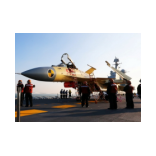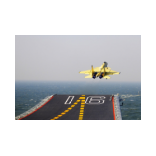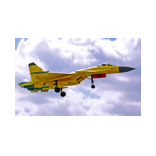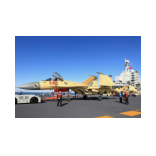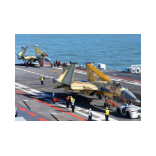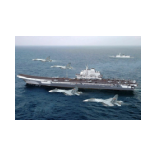J-15 "Flying Shark"
![]() The Shenyang J-15, also known as Flying Shark, is a carrier-based fighter aircraft in development by the Shenyang Aircraft Corporation and the 601 Institute for the Chinese People's Liberation Army Navy's aircraft carriers. Rumors initially claimed the aircraft was to be a semi-stealth variant, yet later reports indicate the aircraft is based on the Soviet-designed Sukhoi Su-33 and is fitted with domestically produced radars, engines, and weapons. An unfinished Su-33 prototype, the T-10K-3, was acquired from Ukraine in 2001 and is said to have been studied extensively, with development on the J-15 beginning immediately afterward. While the J-15 appears to be structurally based on the Su-33, the indigenous fighter features Chinese technologies as well as avionics from the J-11B program.
The Shenyang J-15, also known as Flying Shark, is a carrier-based fighter aircraft in development by the Shenyang Aircraft Corporation and the 601 Institute for the Chinese People's Liberation Army Navy's aircraft carriers. Rumors initially claimed the aircraft was to be a semi-stealth variant, yet later reports indicate the aircraft is based on the Soviet-designed Sukhoi Su-33 and is fitted with domestically produced radars, engines, and weapons. An unfinished Su-33 prototype, the T-10K-3, was acquired from Ukraine in 2001 and is said to have been studied extensively, with development on the J-15 beginning immediately afterward. While the J-15 appears to be structurally based on the Su-33, the indigenous fighter features Chinese technologies as well as avionics from the J-11B program.
Design and development
Russian military experts have downplayed any significant competition from the J-15 in the global arms market, with Col. Igor Korotchenko of the Defense Ministry stating in early June 2010, "The Chinese J-15 is unlikely to achieve the same performance characteristics of the Russian Su-33 carrier-based fighter, and I do not rule out the possibility that China could return to negotiations with Russia on the purchase of a substantial batch of Su-33s." China has actively sought to purchase Su-33s from Russia on numerous occasions—an unsuccessful offer was made as late as March 2009, but negotiations collapsed in 2006 after it was discovered that China had developed a modified version of the Sukhoi Su-27SK designated the Shenyang J-11B, in violation of intellectual property agreements.
The first J-15 prototype is believed to have performed its maiden flight on August 31, 2009, powered by Russian-supplied AL-31 turbofan engines. Video and still images of the flight were released in July 2010, showing the same basic airframe design as the Su-33. In July 2011, it was reported FWS-10H turbofan engine was chosen for J-15 fighter, which has takeoff thrust increased to 12,800 kg, compared to the FWS-10 turbofan's 12,500 kg. Other improvements were also made to make it better suited to carrier-based fighter's requirement. On May 6, 2010, the aircraft conducted its first takeoff from a simulated ski-jump.
The reliance on ski-jump launches and the lack of Chinese carrier based refueling capabilities are believed to greatly reduce the effective range of the J-15.
The J-15 is reported to use different avionics and systems than the Su-33, and uses Chinese-developed technologies, and features various upgrades such as AESA radar, composite and radar absorbent material, MAWS, improved IRST, and new electronics. An article in the China Signpost believes the J-15 "likely exceeds or matches the aerodynamic capabilities of virtually all fighter aircraft currently operated by regional militaries, with the exception of the U.S. F-22 Raptor", alleging that the J-15 likely possesses a 10% superior thrust-to-weight ratio and a 25% lower wing loading than the F/A-18E/F Super Hornet, one of the authors of that same article described the J-15 in another as no game changer; Hu Siyuan of the National Defense University PLA China has said that "the current weak point of the J-15 is its Russia-made Al-31 engines which are less powerful than that of the American F-35 fighter".
A twin seat variant made its maiden flight on November 4, 2012. The general designer of J-15 is Mr. Sun Cong.
The J-15's chief designer, Sun Cong of the National Committee of the Chinese People's Political Consultative Conference, has said that the J-15 could match the F/A-18 in bomb load, combat radius and mobility. However, in a similar statement, he said more work was required in its electronics and combat systems. He also indicated the lack of mature domestically produced engines as a current weak spot.
Rear Admiral Yin Zhuo stated that the aircraft's air combat capabilities were better than that of the F/A-18E/F Super Hornet. However, he also stated that its ability to attack land and sea targets was slightly inferior to the F/A-18E/F. It is also stated that its electronic equipment meets the standards of those on a fifth generation fighter.
Operational history
On 25 November 2012, Chinese media announced that two J-15s had made successful arrested landings on the aircraft carrier Liaoning. The first pilot to land on the Liaoning was named as Dai Mingmeng. PLA Daily newspaper indicated the first five naval pilots including Dai conducted J-15 fighter landing and taking off. Test and training program officials confirmed the carrier-borne aircraft and special equipment for the landing flight had gone through strict tests, and fighter jets can be deployed on the carrier.
In December 2013 Chinese media reported that mass production of J-15s in full operational condition with combat markings had begun.
Specifications
General characteristics
Crew: 1-2
Length: 21.9 m (72 ft)
Wingspan: 14.7 m (48.25 ft)
Height: 5.9 m (19.5 ft)
Wing area: 62.04 m2 (667.80 ft2)
Empty weight: 17500 kg (38600 lb)
Loaded weight: 27000 kg (60000 lb)
Max. takeoff weight: 33000 kg (72752 lb)
Powerplant: 2 × WS-10A afterburning turbofans
Dry thrust: 89.17 kN (20,050 lbf) each
Thrust with afterburner: 135 kN (33,000 lbf) each
Wingspan, wings folded: 7.4 m (24.25 ft)
Performance
Maximum speed: Mach 2.4
Range: 3500 km (2050 mi)
Service ceiling: 20000 m (65700 ft)
Rate of climb: 325 m/s (64000 ft/min)
Armament
1 × 30 mm GSh-30-1 cannon with 150 rounds
Munitions on twelve external hardpoints, including:
8 × PL-12 or R-77, and 4 × PL-9 or R-73 air-to-air missiles
Various bombs and rockets
Anti ship and anti radiation missiles.
Electronic countermeasure (ECM) pods


